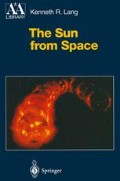Overview
We are protected from the full blast of the Sun’s violent activity by a dipolar magnetic field that diverts charged particles around the Earth and forms a cavity, called the magnetosphere, within the Sun’s relentless winds. The Earth’s magnetic barrier is nevertheless imperfect, and some of the tempestuous solar wind can buffet and even penetrate the magnetosphere. Intense, non-recurrent geomagnetic storms, accompanied by exceptionally bright auroras, occur at times of high solar activity when fast coronal mass ejections hit the Earth’s magnetosphere and have the right magnetic alignment with it. When the Sun is near a lull in its 11-year activity cycle, magnetic waves formed by the Sun’s interacting winds strike the Earth’s magnetic field and connect with it, producing moderate geomagnetic storms and less bright auroras.
High-speed protons and electrons, generated during explosive solar activity, can cripple satellites and endanger space-walking astronauts. Intense radiation due to enhanced solar activity heats the Earth’s upper atmosphere, altering satellite orbits and disrupting communications. When encountering the Earth, coronal mass ejections can compress the magnetosphere below the orbits of geosynchronous satellites, that hover above one place on Earth, and also generate power surges on transmission lines that could cause electrical power blackouts of entire cities. With adequate warning, we can defend ourselves from violent space weather that is driven by the Sun and its winds. National centers and defense agencies therefore continuously monitor the Sun from ground and space to forecast threatening solar activity. As an example, when large, twisted sigmoid (S or inverted S) shapes appear in soft X-ray images of the Sun, they can give advance notice, by a few days, of mass ejections that might collide with the Earth.
Solar X-rays and extreme ultraviolet radiation both produce, and significantly alter, the Earth’s ionosphere. The X-rays fluctuate in intensity by two orders of magnitude during the Sun’s 11-year magnetic activity cycle, producing increased ionization, greater heat, and expansion of our upper atmosphere near activity maximum. This affects the ability of the ionosphere to transmit and reflect radio communication waves. The ozone layer in our stratosphere is both created and modulated by solar ultraviolet radiation, while also protecting us from dangerous ultraviolet sunlight.
The total solar irradiance of the Earth, the so-called solar constant, rises and falls in step with the 11-year solar cycle, but with a total recent change of only about 0.1 percent. When sunspots cross the visible solar disk, they produce, in themselves, a brief dimming of the irradiance, amounting to a few tenths of one percent for just a few days; a brightness increase caused by faculae and plage exceeds the overall sunspot decrease at times of high solar activity. Variations in the Sun’s activity and brightness may be linked to changes in terrestrial climate on time scales of decades and centuries. During the past 130 years, the global sea temperature has varied in tandem with the 11-year cycle of solar magnetic activity, and the land air temperature has been correlated with the length of the solar cycle. These temperature variations might be attributed to solar-driven changes in cloud cover, caused by the Sun’s 11-year modulation of the amount of cosmic rays reaching Earth. Further back in time, over the past millennium, tree ring and ice core studies show rings high in radiocarbon and snow high in beryllium, precipitated over century-long periods when the Sun was inactive and the climate was cold.
During the past one million years, the world’s climate has been dominated by the deep glacial cold of major ice ages, each lasting about 100 thousand years, punctuated by a warm interglacial of 10 to 30 thousand years in duration. The ice ages seem to be caused by three astronomical cycles, which combine to alter the angles and distances from which sunlight strikes the Earth. When the temperature increases it is most likely amplified by increased atmospheric concentrations of carbon dioxide and other greenhouse gases. Future global warming of a few degrees Celsius is forecast for the Earth’s surface temperature in the twenty-first century if current human increases in concentrations of such heat-trapping gases are not curtailed. The Sun’s luminosity has been steadily increasing, by some 30 percent over its lifetime of 4.6 billion years, but some global thermostat has conspired to keep most of the Earth’s water from freezing solid or boiling away during this time. Nevertheless, the Sun will keep on getting brighter, boiling away our oceans in 3 billion years and ballooning into a giant star in another four billion years.
Access this chapter
Tax calculation will be finalised at checkout
Purchases are for personal use only
Preview
Unable to display preview. Download preview PDF.
Author information
Authors and Affiliations
Rights and permissions
Copyright information
© 2000 Springer-Verlag Berlin Heidelberg
About this chapter
Cite this chapter
Lang, K.R. (2000). The Sun-Earth Connection. In: The Sun from Space. Astronomy and Astrophysics Library. Springer, Berlin, Heidelberg. https://doi.org/10.1007/978-3-662-04280-9_7
Download citation
DOI: https://doi.org/10.1007/978-3-662-04280-9_7
Publisher Name: Springer, Berlin, Heidelberg
Print ISBN: 978-3-662-04282-3
Online ISBN: 978-3-662-04280-9
eBook Packages: Springer Book Archive

